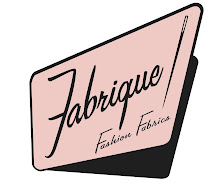Here are a few helpful tips when working with beaded fabrics:
--Most seams will have to be handsewn with small, close stitches. We recommend the Mettler polyester thread, beacause it allows for flexibility.
--If there are beads that are in the seam line and in the seam allowance, you'll need to break them with a ball-peen hammer. Bang on the beads to break them. Breaking the beads allows for the removal without cutting apart the chain thread that is holding all of the pieces together. When working with hand-beaded fabrics, you can simply remove each individual bead.
--It is best to use your zipper foot to sew the seams so that there is not interference from the remaining beads on your garment.
--Bind your seam allowance with tulle, also known as illusion.
--Sometimes the use of clear snaps work well in replacement of the use of a zipper.
Use these helpful tips to make sewing with beaded fabrics much less worrisome. Have a question that we didn't answer? Please post your question and we'll be happy to respond.
Wednesday, April 29, 2009
Wednesday, April 15, 2009
Knit Construction
The construction of knit garments differs from wovens. Knits are easier to work with, and the fit is more forgiving. There is minimal seam finishing involved, but there is some debate about what needle to use when working with knits. Like any other fabric, doing a test sample piece is best to see how your needle performs. There is a general assumption that when working with knits you have to use a ballpoint needle. When testing your fabric, first try your regular universal needle. If that needle is inadequate, then switch to a ballpoint. Every knit reacts differently, so be sure to always test your needle first. Another helpful tip: try using clear elastic as your stay at the neckline and shoulder seams. Also, unlike woven fabrics, often times your seam allowances on a knit piece are small measuring only 1/4". Working on a knit piece and have a question? Post a comment and we'll be happy to help!
Wednesday, April 8, 2009
What pattern size is mine?
Everyone has difficulty choosing what pattern size to use. Especially when you wear a size 6 in retail stores and you look at a pattern and suddenly you're a size 12! You should know that pattern sizing was standardized in 1967. In retail stores, garments utilize vanity sizing...which we all love and appreciate! However, patterns differ in size. To more closely match your shoulders and neck area of a garment, choose the pattern that matches your high bust measurement as opposed to your full bust measurement. Your high bust is directly under your arms and across your back. In other words, it is where your bra strap meets the cup. There are some execptions to this rule, but this advice works well for most women.
Thursday, April 2, 2009
Which rotary cutter is better?
There are many rotary cutters to choose from and they certainly all look the same. So which one is better? If you purchase a rotary cutter with a titanium blade, the life of the blade will last twice as long. For larger, longer cuts on a pattern piece it is best to use the larger blade. When you need to cut into tight corners or small details, you should use a small rotary. If you have a dull spot that consistently shows up, then it's time to replace your blade.
Subscribe to:
Posts (Atom)
